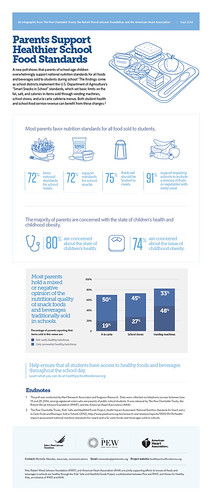
Over the past four years, USDA has worked closely with schools, parents, community leaders, and nutrition experts to ensure that when children go off to school, they are greeted by a healthier school environment. According to the CDC, childhood obesity has more than doubled in children and quadrupled in adolescents in the past 30 years, leading to an increase in obesity-related health outcomes in children, including cardiovascular disease, pre-diabetes, and bone and joint problems. Improving school nutrition is vital to reducing childhood obesity, because many children consume half of their daily calories during the school day. Making the healthy choice the easy choice sets our nation’s children up for a lifetime of healthy choices, and supports a healthier next generation. Recently, we’ve seen evidence that student acceptance of healthier meals is increasing across all grade levels. Today, we are pleased to see the results of the latest poll by The Pew Charitable Trusts, the Robert Wood Johnson Foundation, and the American Heart Association, showing that most parents support the healthier meal and snack standards implemented through the Healthy, Hunger-free Kids Act of 2010.
Read more about the results of that study in this guest blog, from the American Heart Association.
A majority of parents favor strong national nutrition standards for food and drink sold at schools, according to a poll released Monday by The Pew Charitable Trusts, the Robert Wood Johnson Foundation and the American Heart Association.
In addition, the poll found that parents would also like to see salt limited in school foods and more fruits and vegetables served.
The poll, which was conducted in June among 1,112 parents, said that 80 percent of the parents said they were concerned about their children’s health. Seventy-four percent said they were concerned about childhood obesity, a major risk factor for high blood pressure, high cholesterol, high blood sugar and cardiovascular disease later in life. Currently, more than one third of children and adolescents are clinically overweight or obese. Among children ages six to 11, obesity rates rose from 7 percent in 1980 to 18 percent in 2012. The rates increased from 5 percent to 21 percent during that same period for youth ages 12 to 19.
Childhood obesity has been a major national focus, with federal agencies and advocacy organizations, including the American Heart Association, working on ways to curb the trend.
The poll was conducted just weeks before the U.S. Department of Agriculture issued “Smart Snacks” standards on July 1, which mandated that school snacks must be a fruit, a vegetable, protein, dairy, or whole grain; have fewer than 200 calories; and be low in fat, salt, and sugar.
The poll revealed that support for stricter school nutrition standards cut across racial and political lines. Sixty-eight percent of whites, 85 percent of Hispanics and 91 percent of African-Americans said they support the standards.
Fifty-six percent of Republicans, 71 percent of independents and 84 percent of Democrats favored stronger standards. Only 22 percent of parents expressed that they strongly opposed higher school nutrition standards.
Among the poll’s other findings:
- 72 percent favor national standards for school meals;
- 72 percent support standards for school snacks;
- 91 percent support requiring schools to include a serving of fruits or vegetables with every meal;
- 75 percent think salt should be limited in meals;
- 23 percent believed food sold a la carte at schools was nutritious, whereas only 8 percent believed the same of food sold in vending machines.
Penny Kris Etherton, PhD, a professor of nutrition at Pennsylvania State University in University Park, Pennsylvania, said the findings are encouraging, but parents voicing support is just the beginning.
“Schools and parents need to be on the same page about what the kids eat,” she said. “You can’t have one set of standards at school and another set of standards at home. It’s encouraging to see that parents are supportive of higher nutritional standards, but we need to educate across the board so that parents understand what this really means for how their kids should eat.”
Reducing sweetened beverages can lower a child’s intake of “empty” calories, Kris-Etherton explained. However, some parents might believe fruit juice is healthy “when it’s really just sugar water. The child would be better off either drinking plain water or eating a piece of fruit to get the fiber and nutrients from the fruit. The challenge will be making healthy eating fun and interesting for kids.”
The poll was conducted by Hart Research Associates and Ferguson Research. Pew, RWJF, and AHA are jointly supporting efforts to ensure all foods and beverages in schools are healthy. The Kids’ Safe and Healthful Foods Project is a collaboration between Pew and RWJF. Voices for Healthy Kids is an initiative of RWJF and AHA, with Pew providing additional expertise.
